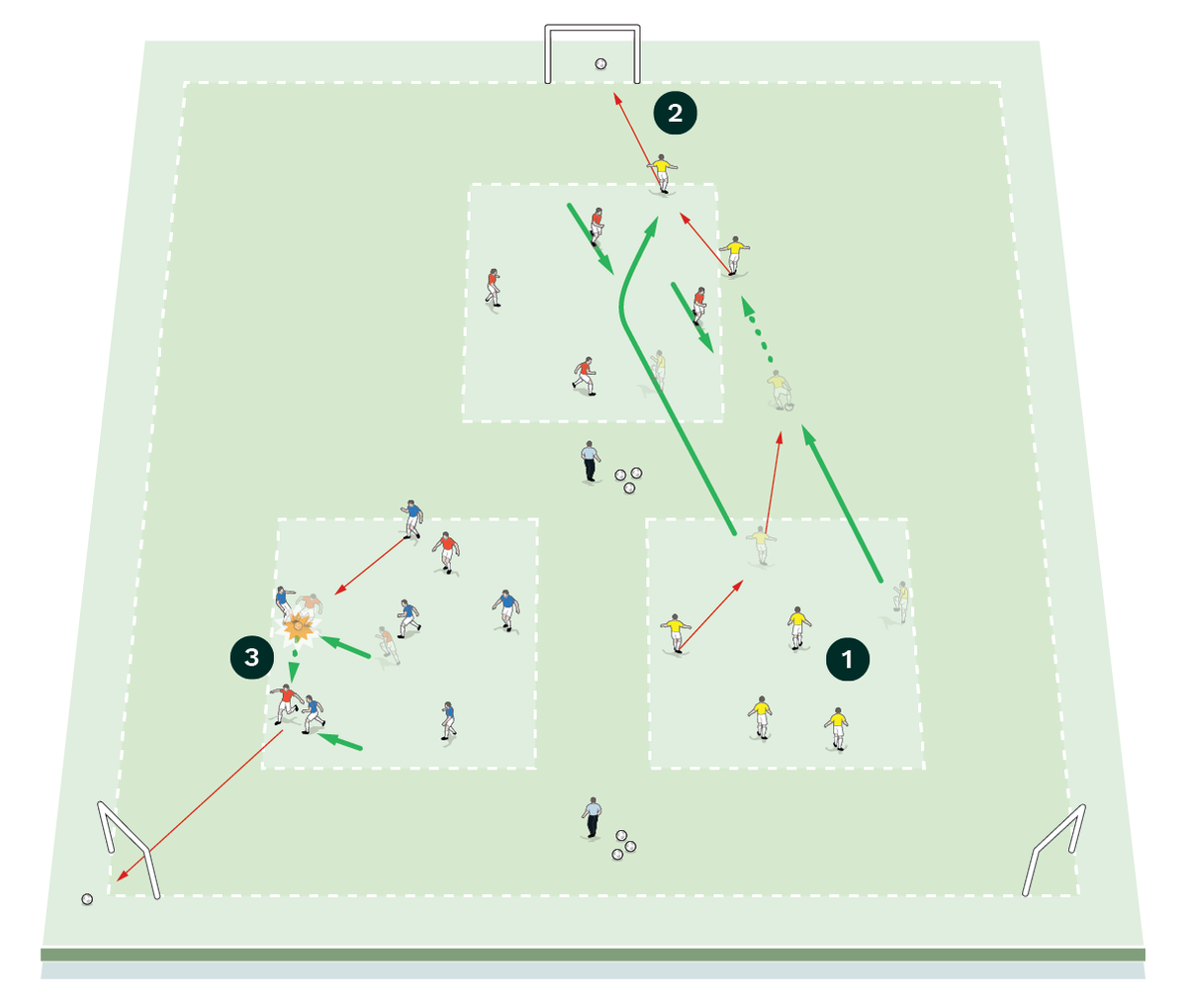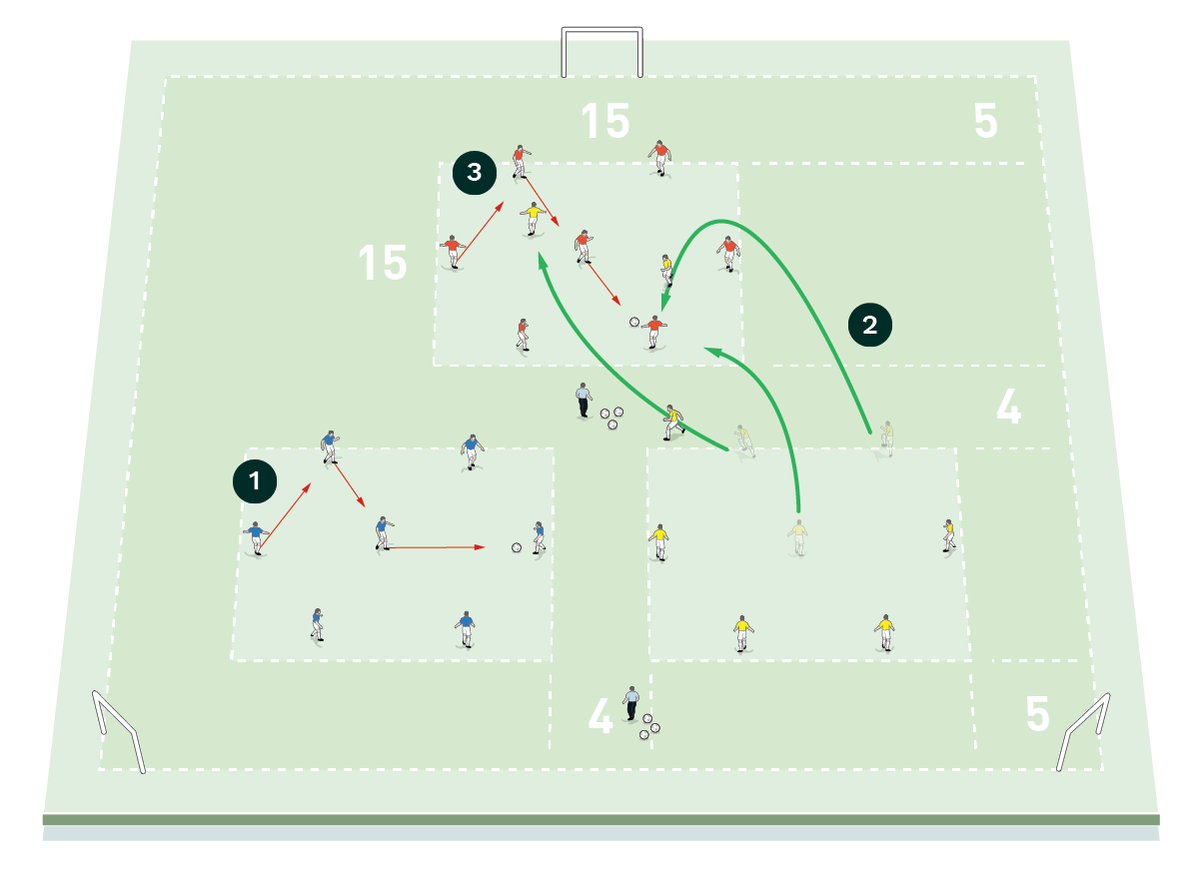




OUR BEST EVER OFFER - SAVE £100/$100
JOIN THE WORLD'S LEADING PROFESSIONAL DEVELOPMENT PROGRAMME
- 12 months membership of Elite Soccer
- Print copy of Elite Player & Coach Development
- Print copy of The Training Ground
Intensive boxes drill with goals
The session is about keeping possession of the ball in small spaces.
| Area | Up to half pitch |
| Equipment | Balls, bibs, cones, three mini goals |
| No. of Players | Up to 21 |
| Session Time |
6v2, 3 teams: 15mins |
The session is about keeping possession of the ball in small spaces.
I like the exercise because it makes the rondo experience more complete. Sometimes we use the rondos as activation drills without many tactical goals, and don’t focus on the defensive side. Introducing goals and specific rules makes the exercise much more interesting.
It is not an exercise used as the main part of the session so we can use it almost any day. I don’t recommend using any exercise more than once or twice a month because we can lose some interest from the players. It is not good to burn the drills, even if we like them.
“I like the exercise because it makes the rondo experience more complete”
6v2, 3 teams
We set up with three 10-yard boxes, with a mini goal set back from each as shown. We’re using three teams of six players, each team with its own box.
Two boxes start playing at the same time, playing the ball around in an attempt to complete 10 passes. Players are limited to 1.5 touches – that’s to say a maximum of three touches between two players.
The team without a ball sends two players to regain the ball from a playing square [1a].
[1a]

-
Each team has a box, the red team and the blue team each start with a ball
-
Two players from the yellow team go into the reds’ box to try to win the ball back
- The yellow players win the ball back and play it back into their box, where they look to make 10 passes
- The red team send two players into the blue area to win the ball back
If they regain it they have the option to score straight away, worth one goal, or pass it back to their zone and keep playing.
The team that lost the ball then sends two players to win the ball back in the other box.
If the team in possession completes 10 passes, they can score in the goals next to the other two boxes. To do so they must lift the ball or find a line between the opposite players [1b].
[1b]

-
The yellow team complete 10 passes before playing the ball into the red box
- The yellow team break the lines between the red players and score a goal, which counts for
two points - The red team regain the ball in the blue box and score, which counts for one point
“If a team regains possession, they have the option to score straight away, worth one goal, or pass it back to their zone and keep playing”
Play continues in this way [1c] for three sets of 4-5 minutes.
[1c]

-
Play restarts, this time the reds and yellows have possession of a ball
- The blue team sends two players to win the ball back from the yellow team
7v3 or 4, 3 teams
Once players have mastered the 6v2, we can make it richer with the same concept, but using more positional structures in each zone, using teams of seven, for example.
We set up with three 15x10-yard boxes, with a mini goal set back from each, as shown. We’re using three teams of seven players, each team with its own box and set up in a 2-3-2.
Each player is limited to three touches. Teams send three or four players to regain possession [2].
[2]

-
Each team has a box, the red team and the blue team each start with a ball
- Three players from the yellow team go into the red area to try to win the ball back
- The red and blue teams look to complete 10 passes to allow them to attack another goal
The rules and scoring systems remain the same as in the 6v2 practice.
Play continues in this way for three sets of 4-5 minutes.
We can then move into a game situation, by relating it more precisely to a situation where we are looking to improve the decision making of the players, especially in the moments where we recover the ball. Is it worth it to attack immediately or is it better to play safer and keep control? Also, we’ll consider the reaction of the team losing the ball to counter press and block the shots if necessary.
COACHING POINTS
What are the key things to look for?
We focus on the offensive side (body shape, angles, ball speed), the defensive side (reaction to press, covering passing lines, aggression) and both transition moments (look to attack as I recover, counter press).
What are the typical mistakes players might make and how do I avoid them?
Typically, players don’t use all the space available and don’t move to offer the best passing lines. Also, if we are playing 1.5 touches, and a player has already spent two touches themselves, they must think about the weight of the pass to their team-mate who is now limited to one touch.
Related Files
Editor's Picks
Attacking transitions
Deep runs in the final third
Using the goalkeeper in build-up play
Intensive boxes drill with goals
Penetrating the final third
Creating and finishing
My philosophy
Pressing initiation
Compact team movement
Coaches' Testimonials

Alan Pardew

Arsène Wenger

Brendan Rodgers

Carlos Carvalhal

José Mourinho

Jürgen Klopp

Pep Guardiola

Roy Hodgson

Sir Alex Ferguson

Steven Gerrard
Coaches' Testimonials

Gerald Kearney, Downtown Las Vegas Soccer Club

Paul Butler, Florida, USA

Rick Shields, Springboro, USA

Tony Green, Pierrefonds Titans, Quebec, Canada
Join the world's leading coaches and managers and discover for yourself one of the best kept secrets in coaching. No other training tool on the planet is written or read by the calibre of names you’ll find in Elite Soccer.
In a recent survey 92% of subscribers said Elite Soccer makes them more confident, 89% said it makes them a more effective coach and 91% said it makes them more inspired.
Get Monthly Inspiration
All the latest techniques and approaches
Since 2010 Elite Soccer has given subscribers exclusive insight into the training ground practices of the world’s best coaches. Published in partnership with the League Managers Association we have unparalleled access to the leading lights in the English leagues, as well as a host of international managers.
Elite Soccer exclusively features sessions written by the coaches themselves. There are no observed sessions and no sessions “in the style of”, just first-hand advice delivered direct to you from the coach.








